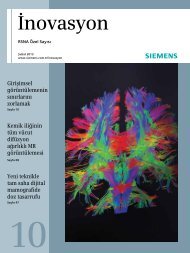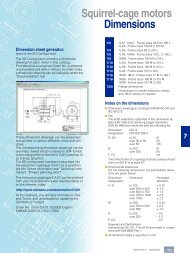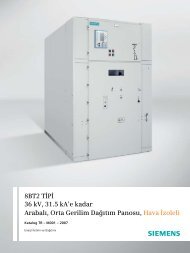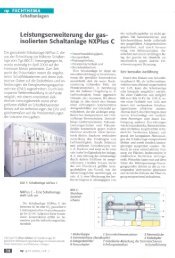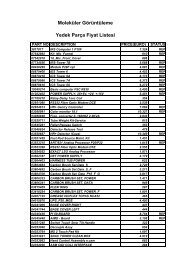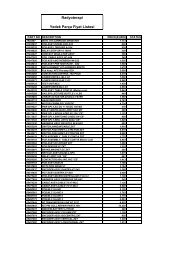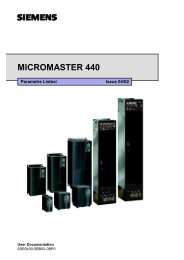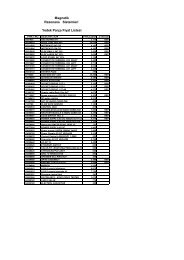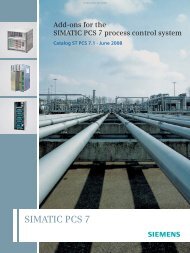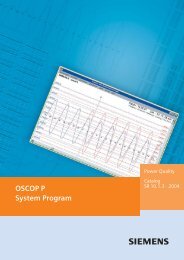SIPROTEC 4 7SJ63 Multifunction Protection Relay - Siemens
SIPROTEC 4 7SJ63 Multifunction Protection Relay - Siemens
SIPROTEC 4 7SJ63 Multifunction Protection Relay - Siemens
You also want an ePaper? Increase the reach of your titles
YUMPU automatically turns print PDFs into web optimized ePapers that Google loves.
5 Overcurrent <strong>Protection</strong> / <strong>7SJ63</strong><strong>Protection</strong> functions/FunctionsFault locator (ANSI 21FL)The fault locator specifies the distance to afault location in kilometers or miles or thereactance of a second fault operation.Circuit-breaker wear monitoringMethods for determining circuit-breakercontact wear or the remaining service life of acircuit-breaker (CB) allow CB maintenanceintervals to be aligned to their actual degreeof wear. The benefit lies in reduced maintenancecosts.There is no mathematically exact method ofcalculating the wear or the remaining servicelife of circuit-breakers that takes into accountthe arc-chamber's physical conditions whentheCBopens.Thisiswhyvariousmethodsofdetermining CB wear have evolved which reflectthe different operator philosophies. Todo justice to these, the devices offer severalmethods:• I•ΣI x , with x = 1... 3The devices additionally offer a new methodfor determining the remaining service life:• Two-point methodThe CB manufacturers double-logarithmicswitching cycle diagram (see Fig. 5/117) andthe breaking current at the time of contactopening serve as the basis for this method.After CB opening, the two-point method calculatesthe number of still possible switchingcycles. To this end, the two points P1 and P2only have to be set on the device. These arespecified in the CB's technical data.Allofthesemethodsarephase-selectiveandalimit value can be set in order to obtain analarm if the actual value falls below or exceedsthe limit value during determination ofthe remaining service life.Customized functions (ANSI 32, 51V, 55, etc.)Additional functions, which are not timecritical, can be implemented via the CFC usingmeasured values. Typical functions includereverse power, voltage controlledovercurrent, phase angle detection, and zerosequencevoltage detection.CommissioningCommissioning could hardly be easier and isfully supported by DIGSI 4. The status of thebinary inputs can be read individually andthe state of the binary outputs can be set individually.The operation of switching elements(circuit-breakers, disconnect devices)can be checked using the switching functionsof the bay controller. The analog measuredvalues are represented as wide-ranging operationalmeasured values. To prevent transmissionof information to the control centerduring maintenance, the bay controller communicationscan be disabled to prevent unnecessarydata from being transmitted. Duringcommissioning, all indications with testmarking for test purposes can be connectedto a control and protection system.Test operationDuring commissioning, all indications canbe passed to an automatic control system fortest purposes.n Control and automatic functionsControlIn addition to the protection functions, the<strong>SIPROTEC</strong> 4 units also support all controland monitoring functions that are requiredfor operating medium-voltage or high-voltagesubstations.The main application is reliable control ofswitching and other processes.The status of primary equipment or auxiliarydevices can be obtained from auxiliary contactsand communicated to the <strong>7SJ63</strong> via binaryinputs. Therefore it is possible to detectand indicate both the OPEN and CLOSEDposition or a fault or intermediate circuit-breakeror auxiliary contact position.The switchgear or circuit-breaker can becontrolled via:– integrated operator panel– binary inputs– substation control and protection system– DIGSI 4Automation / user-defined logicWith integrated logic, the user can set, via agraphic interface (CFC), specific functionsfor the automation of switchgear or substation.Functions are activated via functionkeys, binary input or via communicationinterface.Fig. 5/117CB switching cycle diagramSwitching authoritySwitching authority is determined accordingto parameters, communication or by keyoperatedswitch (when available).If a source is set to “LOCAL”, only localswitching operations are possible. The followingsequence of switching authority is laiddown: “LOCAL”; DIGSI PC program,“REMOTE”.Key-operated switch<strong>7SJ63</strong> units are fitted with key-operatedswitch function for local/remote changeoverand changeover between interlocked switchingand test operation.Command processingAll the functionality of command processingis offered. This includes the processing of singleand double commands with or withoutfeedback, sophisticated monitoring of thecontrol hardware and software, checking ofthe external process, control actions usingfunctions such as runtime monitoring andautomatic command termination after output.Here are some typical applications:• Single and double commands using 1,1 plus 1 common or 2 trip contacts• User-definable bay interlocks• Operating sequences combining severalswitching operations such as control ofcircuit-breakers, disconnectors andearthing switches• Triggering of switching operations, indicationsor alarm by combination withexisting information51) The 45 to 55, 55 to 65 Hz range isavailable for f N= 50/60 Hz<strong>Siemens</strong> SIP · 20065/125



